
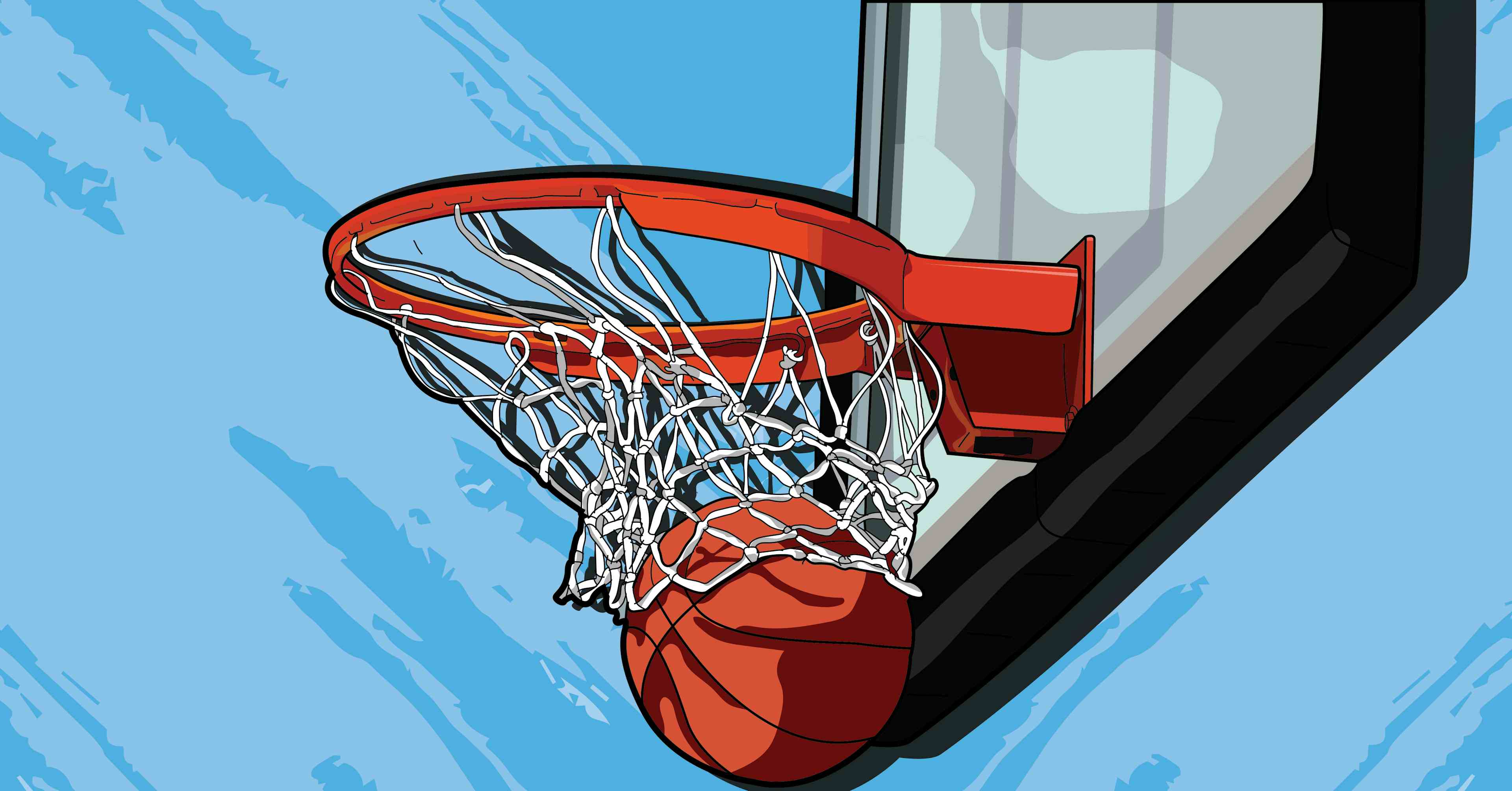
No matter the forum, whether it’s your uncle’s driveway or an online basketball fan group, someone is likely to bring up the most annoying basketball question of all time: Why does nobody watch the WNBA?
In fact, this question is so persistent, that it led us to start this website. So while SportsCenter on ESPN dedicates just two percent of its airtime to covering women’s sports, Queen Ballers Club will spend one hundred percent of its editorial airtime on women’s fascinating athletic feats.
But before we get too caught up in the future, let’s go back to the beginning of this wicked rumor.
It all started in 1996, when the Women’s National Basketball Association (WNBA), a competitive, professional basketball league, was founded as a counterpart to the National Basketball Association (NBA). Since then, the WNBA has blossomed into twelve teams that typically compete for six months of the year.
The league consistently puts on a show! And gets better every year, as it draws from an incredible NCAA Division I college talent pool. Furthermore, many of its stars, such as Lisa Leslie and Diana Taurasi, have gone on to become household names worldwide.
So, today we’re going to explore the many factors that contribute to this question’s prevalence and reveal the ultimate conclusion. We’ll cover who is watching the WNBA (you can tune in for the 2021 schedule here!), why the league struggles to be taken as seriously as it should be, and what steps can be taken to ensure its long-term survival. The answers might surprise you.
One of the first punches commonly thrown against the WNBA is that it doesn’t have substantial viewership to justify keeping it afloat. Let’s just put that to rest up front. This year in 2021, NBA TV’s season opening WNBA telecast (Indiana/New York) on Friday, May 14th delivered a 27% viewership increase versus last year’s comparable telecast (Washington/Connecticut). And the average viewership of the first five games of the 2021 season was 357,000- a 74% increase versus 2020.
The WNBA capped off its historic 25th regular season by delivering its most-watched season since 2008 for its television partners – ABC, CBS, ESPN and ESPN2 — viewership was up 51% over the 2020 season. And the 2021 WNBA Finals Game 2 was the most watched Game 2 since 2003, peaking with 1 million viewers. Game over!

Already back in 2014, WNBA games had 659,000 viewers according to ESPN. So while it’s true that the WNBA doesn’t pull the same numbers as the NBA (1.46 million viewers), the criticism that “no one” is watching the WNBA is as stale as it is unfair.
In recent years, the WNBA has seen promising increases in viewership and revenue that fly directly against the narrative that no one is interested in watching women’s basketball.
Forbes contributor David Berri quoted a source who said a conservative estimate of the WNBA’s revenue would be $60 million. WNBA revenue has also been estimated as $70 million in 2019. Though the WNBA has lost more than $10 million a year since its inception in 1997, according to the NBA, reports The Washington Post.
With committed partnerships from ESPN, ESPN2, ABC, and CBS Sports, the WNBA’s 2019 season saw strong results. The first three games each averaged 413,000 viewers – a sixty four percent increase from the first four games of 2018.
Meanwhile, in-game attendance over the league’s entire history averages out at between 7,245 and 8,377, depending on the month. That’s enough people to fill about 200 buses: a lot!
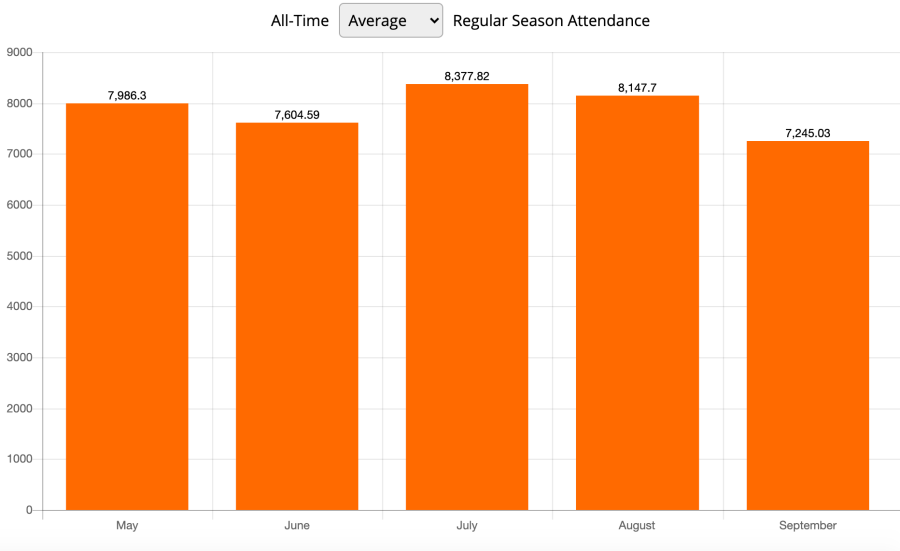
Additionally, the 2020 WNBA draft, featuring #1 pick Sabrina Ionescu, had 387,000 viewers. And the draft generated 6.5 million video views on social media.
Also, the WNBA sees higher social engagement on Twitter and Instagram than the NBA. And the women’s NCAA Tournament’s social media engagement in 2021 also reached double the impressions of the men’s.
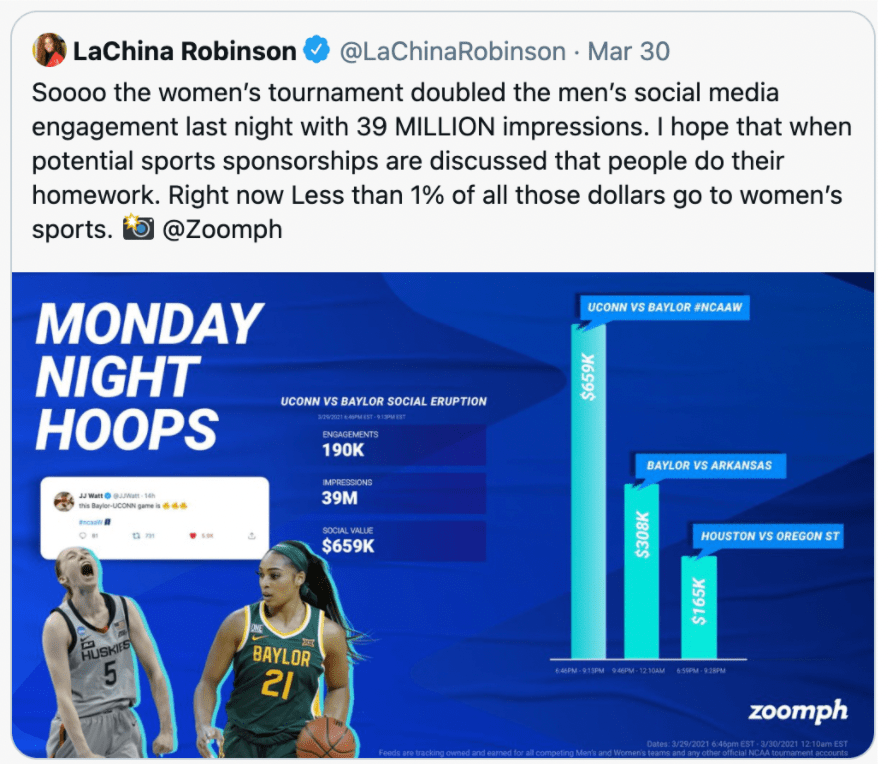
Also, according to The New York Times, gate receipts, while critical, do not solely determine a franchise’s value. The fact that since 2009 WNBA teams have been sold but not shut down hints that they aren’t incurring debt.
They could be attracting fans new to basketball who then go to NBA games. They may also, through creative financial arrangements, like paying rental fees to facilities controlled by their owner, claim tax-deductible losses while legally generating revenue elsewhere.
And, already in 2014, the WNBA’s president, Laurel Richie, told the Sports Business Journal that some of the franchises had begun to see profits. These franchises were all at least 10 years old, had owners with significant resources to spend on them, were in a basketball-hungry locale, and had won or played for a championship.
Prior to their successful deals with major sports networks, the WNBA already had a strong supporter base. As with most other professional sports, fans are drawn to support their local teams. And there is no shortage of examples when it comes to fervent fans of the WNBA. For example:
Plus, stars with their own storylines continue to emerge. In fact, the WNBA’s social media presence – specifically on Twitter – has helped players become more visible to fans. It has led to Twitter “takeovers” with the league’s budding stars such as A’ja Wilson, Chiney Ogwumike, Chelsea Gray, and more.
Because the league is smaller, with only 12 teams compared to the NBA’s 30, the distribution of talent across the WNBA is much more uniform. This makes for closer games, countless moments of in-game magic, and highly competitive battles for the championship — all of which drive more eyeballs.
The WNBA Google search trend line very clearly corresponds with in-season periods. As a result, it appears that enthusiasts have more trouble finding ways to watch the WNBA, so they are proactively looking for any coverage by searching online.
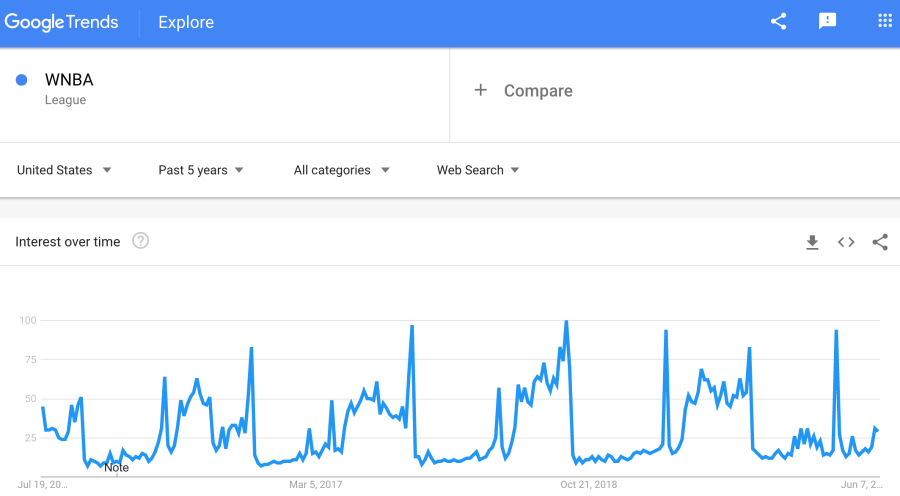
This trend shows that the interest around the league’s brand is there in a major way. Because since 2004, it’s clear the searches for the WNBA have been growing, and are now almost double what they were 10 years ago. Currently there are between 100,000 and 1.2 million searches for the league each month.
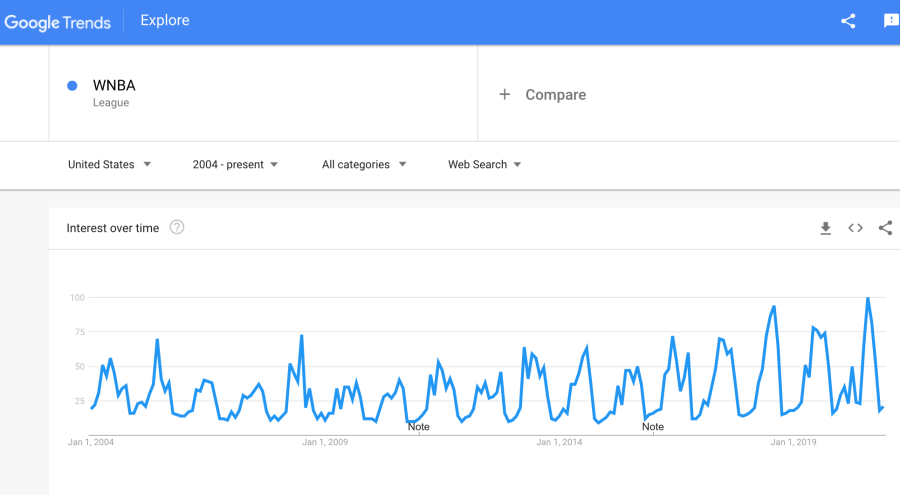
The good news is, there are plenty of fans excited to watch the WNBA. But while the league has overcome many hurdles since its first seasons, there’s still room to grow.
There are four primary talking points when it comes to discussing the challenges that the WNBA faces in reaching more mainstream success: sexism, public interest, marketing strategy, and media coverage. All of these issues are entangled with one another, creating a hamster wheel of obstacles for the league.
Sexism is one of the most intangible issues that the WNBA faces. And is a battle that womankind has faced both within and outside of the world of professional athletics. The debate about gendered wage disparity is a key battleground for overcoming institutionalized sexism in athletics. And the WNBA has recently been on the forefront of that conversation.
Often, pundits and commentators will suggest that by seeking out equitable wages, the players in the WNBA are suggesting that their salaries should exactly match that of the players in the NBA. But WNBA player Kelsey Plum made the case for closing the wage gap saying:
“I’m tired of people thinking that us players are asking for the same type of money as NBA players. We are asking for the same percentage of revenue shared within our CBA. NBA players receive around 50% of shared revenue within their league, whereas we receive around 20%.”
After drawing attention to the wage gap issue and the formation of the Women’s National Basketball Players Association (WNBPA), the WNBA has committed to splitting revenue equally with its players by 2021 with this contract lasting through 2027.
With competitive salaries and benefits, the league hopes to better hold onto star players and create a legacy for the league that fans will be enthusiastic to be a part of.
In the words of WNBA Commissioner Cathy Englebert,
“We believe this is the best deal to drive a return on investment during the term of this agreement…a lot of these elements are setting up the future for the next generation of players to be in a great place — for the current stars to leave behind a legacy for the next generation.”
Furthermore, because the two leagues were founded together, comparisons run rampant. But expecting the WNBA to perform in parallel to a league more than double its size, with a legacy that stretches back more than half a century, is misleading.
Building off of the conversation surrounding wage disparity in the WNBA, it’s important to look at its failure to recruit the sports top stars as they complete their tenure with the NCAA. College basketball, both men’s and women’s, is one of the country’s most popular broadcast sporting events. The NCAA tournament’s March Madness coverage consistently draws nearly 10 million viewers per game.
Fans of college basketball are often excited to follow the careers of players from their favorite teams as they transition into the professional basketball arena. However, because of financial incentives, many incredible talents in women’s basketball accept offers to play in professional leagues overseas, such as the European Women’s Basketball League (EWBL).
The public is more than interested in watching competitive women’s basketball, but the league has struggled for many years to bring in the players that fans are excited to watch.
Furthermore, Gianna Bryant was one of the best influences to ever happen to the league. Because Kobe Bryant started showing up at WNBA games, and investing in women in sport, public interest was drawn to the women’s sport. This led to even more NBA players such as LeBron James, Anthony Davis, and Quinn Cook spotted court-side, growing the love of the women’s game in the public court of opinion.
So, there is a public who loves watching high-performance basketball with women athletes, but how can the WNBA get them to watch and support the league in addition to recruiting the world’s best players?
A significant amount of the funding for the WNBA’s marketing budget comes from the NBA, which is why comments from NBA Commissioner Adam Silver saying the WNBA has a “marketing problem” don’t exactly inspire confidence. For most of the league’s early years, the WNBA relied on the same marketing firm that put together advertising packages for the NBA and was failing to reach the league’s key target demographic: young women.
Much of the WNBA’s recent success can be attributed to pivoting their marketing strategy away from converting NBA fans, and towards attracting young women who may not previously considered themselves part of the professional athletics space.
Under the leadership of WNBA President Lisa Borders, the league began working with branding consultants at Sylvain Labs in 2018. Since then, they’ve pivoted away from the marketing model that mirrored that of the NBA.
By focusing on players’ individual stories, these updated attempts at advertising outreach have paid off, leading to increased ticket sales, merchandise revenue, and viewership numbers. And recently, the league itself introduced a brand “reset,” promoting its players as “badass ballers and dynamic women who challenge convention and shape culture.”
Alongside these marketing outreach efforts, there is also a push to reboot how the mainstream sports media covers the WNBA.
The media attention that the WNBA receives today leans heavily on the league’s controversies and scandals. Just see the latest news cycles around:
While the controversies are important to cover, there is an upsetting lack of sincere discussion regarding the athletes’ performances in the league. Because of this shallow coverage, fans have fewer opportunities to connect and engage in WNBA-related discussions.
As SwishAppeal‘s Carly Regehr articulated, compared to the NBA,
“It feels like one really has to dig deep online to find player information and summaries of past seasons, turning basic knowledge into an Easter egg hunt. That alone points at the minimum coverage that WNBA players receive, which hurts the league. Finding information on an NBA player, though, is available with a click of a button.”
“I think exposure on television is a material part of changing the game here,” Alisha Valavanis, the chief executive and general manager of the Storm, says. “We need the WNBA accessible to every household in the country.”
Adam Silver, the NBA’s commissioner, on the other hand, shared that attendance is the most important ingredient in a league’s success and must come first: “It’s also our experience that, from a media standpoint, unless you have a vibrant arena, unless you have an active audience in your buildings, it diminishes the quality of your presentation. Because there’s no energy around the telecast.”
And yet, last year, TV ratings for NBA games declined 5 percent, while those for WNBA games, though much lower in absolute numbers, increased 64 percent, despite being available mostly on cable channels — and then only erratically.
If the mainstream sports media were to give the WNBA the same level of prime-time coverage that it gives all other major American sports leagues, more new fans would be converted and the league would garner the legitimacy its athletes deserve.
There have already been great strides made in this area. For example:
Short answer: yes, absolutely. According to former WNBA President Lisa Borders,
“The WNBA is here to stay and survive, but we are also here to thrive.”
In recent years, the WNBA has seen a promising rise in viewership that suggests it’s on track to reach thriving status. But there is still more work to be done.
The product is there: “The respect that the league garners in the basketball world is very high,” Kara Lawson, a former W.N.B.A. player who is an assistant coach for the Boston Celtics, said. “N.B.A. players and coaches are passionate about the league.”
But in order for the WNBA to be taken seriously by sports audiences, it has to be taken seriously by the industry of professional athletics as a whole. We need more coverage of Leilani Mitchell and less about domestic abuse.
Major sports networks need to continually commit to promoting the WNBA. Sports journalists who cover the WNBA also need to put a concerted effort into highlighting the games and athletic efforts, as much as they air the controversies and gossip.
The 2021 NCAA Women’s Tournament is a great example of what can happen when you put women’s basketball on prime time television.
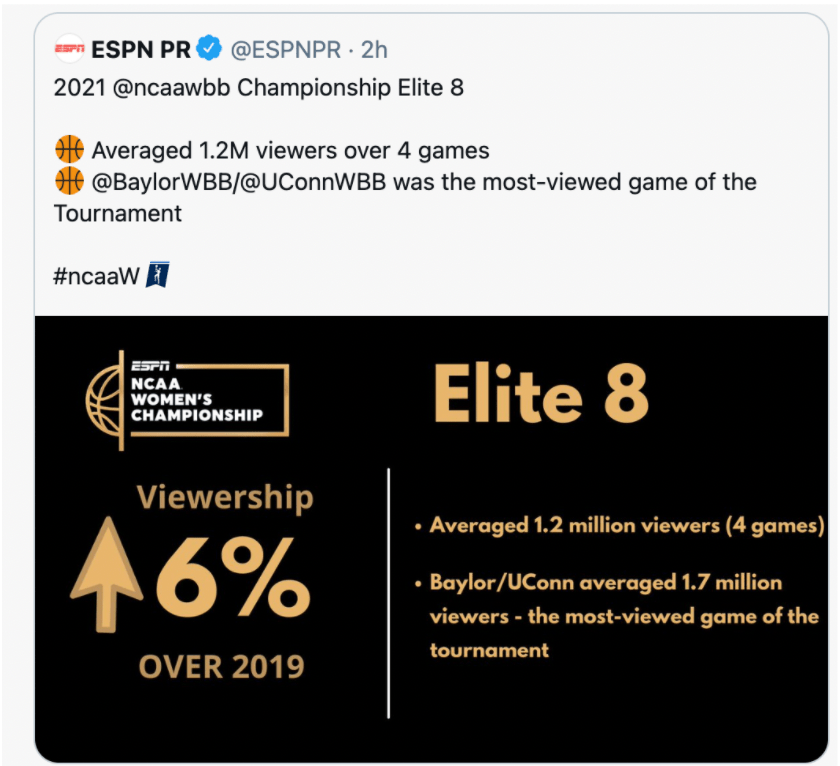
The fact that the WNBA continues to survive in spite of criticism, speaks to the league’s importance when it comes to representing women, both in professional athletics and in every life arena. And there are plenty of ways to continue to invest in its success.
Recently, Lindsay Kagawa Colas, co-founder of Athletes for Impact, put together a list of immediate, tangible actions to take to support women’s professional athletics, particularly the WNBA, that includes:
And, we’d recommend posting to your Facebook page or any social media channel, anytime you’re watching a game, to share the love.
In order to be taken seriously as a league, one of the WNBA’s goals will be to become profitable independent of the NBA. Sponsors would be wise to partner with the WNBA and its strong, established viewer base, to invest in the exciting rise of professional women’s basketball.
For example, Mountain Dew, an NBA partner, made its first personal endorsement of a WNBA player, the Las Vegas Aces forward A’ja Wilson, and offered her equal placement with NBA athletes in its ad campaigns. And Converse signed its first WNBA shoe deal with Natasha Cloud.
Ultimately, the assertion that nobody is watching the WNBA is simply not true. It rests largely on an outdated narrative perpetuated by people who have no skin in the game. If you hear someone spewing that “nobody watches the WNBA” the best step you can take is to say something, bring the facts to their attention, and use the language of the movement.
While the league is still working to improve financially, it’s important to recognize that this is not a phenomenon exclusive to the WNBA. In its early years, the American Football League (AFL) had to fight to establish itself, struggling to pay and recruit players. More than 60 years later, the AFL is still a major force in professional sports.
The WNBA is a young league that is under an inconceivable amount of pressure to perform, and to prove that women deserve to be in the professional athletics spotlight as much as their male counterparts. The WNBA’s ability to persevere through financial issues, damaging sexist rhetoric, and lack of media attention highlights that this league is critical.
The fight for the WNBA is a fight not only for its remarkable athletes, but also for the women who will come after them. Representation matters. And the WNBA’s success is vital to the dreams of young girls and boys everywhere who hope to rise to the top of their game in a world that treats them with the respect they deserve.
“It’s about future generations who want to play the game at the highest level and want respect while doing so.”
WNBPA executive director Terri Jackson told Katie Strang of The Athletic.
It seems like the question we should be asking isn’t why does nobody watch the WNBA, but why doesn’t everybody?
Up next see how to watch WNBA games. Or learn more about WNBA history.
Would you be willing to send a $5 tip to our Venmo tip jar because it helps support this site and our reporting? @megsterr.
Or our Paypal: